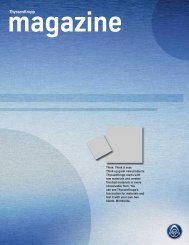Engineering
Engineering
Engineering
You also want an ePaper? Increase the reach of your titles
YUMPU automatically turns print PDFs into web optimized ePapers that Google loves.
3.6 Consolidated financial statements Notes to the consolidated financial statements<br />
If in a subsequent period, the amount of the impairment loss<br />
decreases and the decrease can be related objectively to an event<br />
occurring after the impairment was recognized, the previously<br />
recognized impairment loss is reversed through profit or loss.<br />
If the decrease in fair value of an available-for-sale financial asset was<br />
previously recognized directly in equity, such loss is transferred from<br />
equity to profit or loss as soon as an objective evidence of an<br />
impairment loss exists. The amount of the impairment represents the<br />
difference between historical cost (less any redemption and<br />
amortization) and the current fair value less any impairment loss on<br />
that financial asset previously recognized in profit or loss. Impairment<br />
losses on equity instruments classified as available-for-sale and<br />
recognized in the income statement are not reversed through profit or<br />
loss, but rather through equity. The amount of any reversal of any<br />
write-down of debt instruments, which objectively occurred after the<br />
impairment was recognized, is recognized in profit or loss.<br />
Financial liabilities<br />
Financial liabilities are liabilities that must be settled in cash or other<br />
financial assets. These especially include trade accounts payable,<br />
derivative financial liabilities and components of financial debt, mainly<br />
bonds and other securitized liabilities, liabilities to financial institutions<br />
and finance lease liabilities. Financial liabilities are initially carried at<br />
fair value. This includes any transaction costs directly attributable to<br />
the acquisition of financial liabilities, which are not carried at fair value<br />
through profit or loss in future periods.<br />
Trade accounts payable and other non-derivative financial<br />
liabilities<br />
Trade accounts payable and other non-derivative financial liabilities are<br />
in general measured at amortized cost using the effective interest<br />
method. Finance charges, including premiums payable on redemption<br />
or settlement, are periodically accrued and increase the liabilities’<br />
carrying amounts unless they have already been settled in the period<br />
in which they were incurred.<br />
Consolidated financial statements<br />
138 | 139<br />
Financial liabilities carried at fair value through profit or loss<br />
The Group does not use the option to categorize financial liabilities at<br />
fair value through profit or loss when initially recognized.<br />
Financial liabilities held for trading<br />
Derivatives that are not part of an effective hedge accounting in<br />
accordance with IAS 39 must be classified as “held for trading” and<br />
thus carried at fair value through profit or loss. In the event of negative<br />
fair values, such derivatives are recognized as “financial liabilities held<br />
for trading”.<br />
Derivative financial instruments<br />
The Group generally uses derivative financial instruments to hedge its<br />
exposure to foreign currency exchange rate, interest rate and<br />
commodity price risks arising from operational, financing and<br />
investment activities. Derivatives are used generally to hedge existing<br />
or anticipated underlying transactions. Such derivatives and so-called<br />
“embedded derivatives”, which are an integral part of a non-derivative<br />
host contract and must be accounted for separately, are measured<br />
initially and subsequently at fair value through profit or loss. Gains or<br />
losses due to fluctuations in fair value are recognized immediately in<br />
profit or loss.<br />
If derivatives are used to hedge the exposure to variability in cash<br />
flows and to hedge balance sheet items, the hedging relationship<br />
qualifies for hedge accounting under IAS 39 if certain conditions are<br />
met. This can reduce volatility in the income statement. There are three<br />
types of hedging relationships: fair value hedge, cash flow hedge and<br />
hedge of a net investment in a foreign operation.<br />
In a fair value hedge, which is a hedge of the exposure to changes in<br />
fair value of a recognized asset or liability or an unrecognized firm<br />
commitment, the hedging instrument is stated at fair value and any<br />
changes in fair value are immediately recognized in profit or loss.<br />
Changes in fair value of a hedged asset, liability or firm commitment,<br />
which are attributable to a particular hedged risk, are also recognized

















